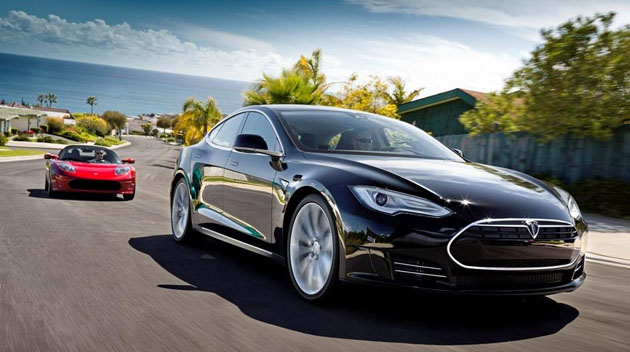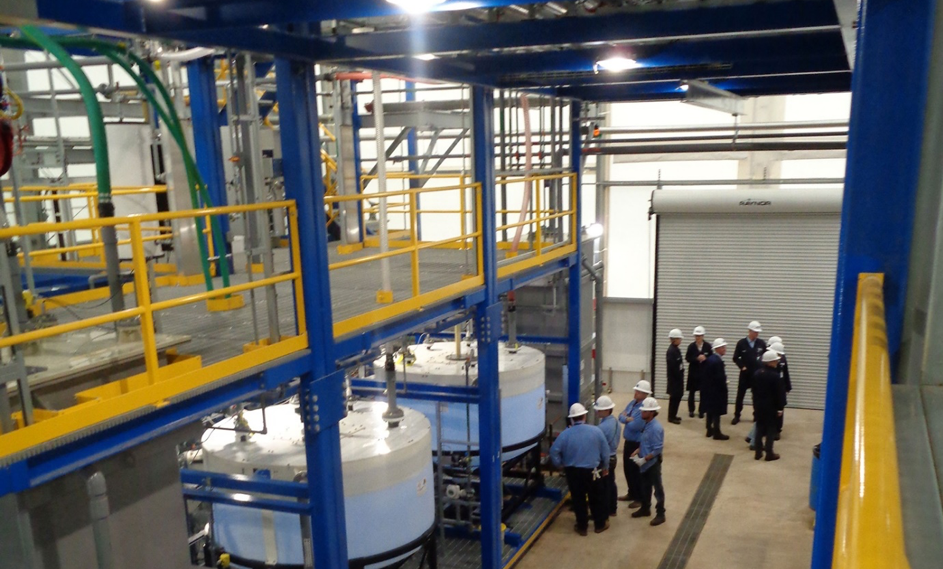Lithium Batteries for Autos and Home Storage
Someday, as sneaky years whisper past, batteries will be seen to have been a crucial wave of the investing future. Uses for lithium ion batteries (LIB) are expanding and will be the main technology for mobility and stationary storage for many years to come. LIB's have been improved over the last 25 years, but it might take that long for any new battery design to pass through the development process to ensure they are safe for consumer use. Electrification of vehicles and the storage of green energy is driving massive growth in LIB cell manufacturing, forecast to increase 170% from today's current capacity of 103 GwH to 278 GwH by 2021 to meet the demands of electrification of automotive vehicles. Also, lithium batteries will be used for stationary storage in houses; they would charge with wind or sunlight present, to be consumed later. Many will buy rooftop solar along with batteries. The 2015 world market value of lithium ion batteries was $18 billion and is forecast to double to $36 billion by 2025—which we personally believe will be much larger.
Auto sales in the US and Europe exceed 30 million and forecasts are that 20% of cars sold will be electric vehicles by 2025. This would require over 350 GwH produced a year by battery. By 2030 the annual sales of electric vehicles could be around 21 million, with an estimated 70-80-million electric vehicles on the road worldwide. Incidentally, China's goal is to have 5-million electric cars by 2020, with each electric vehicle also needing around three times more copper than a regular car. China expects to need 50,000 tons more copper annually for these electric vehicles. Copper's recent prices are now flat, and are at a critical juncture related to its trendlines.
There are over a half-dozen battery Gigafactories being considered in the US, and a further half-dozen in Europe, far in excess of current capacity. Tesla has built a plant with a 35 GwH capacity, intending to grow it to 150 GwH, while Northvolt is planning a gigaplant in Sweden. This will not be enough to match demand in Europe and America, so a further 50-100 GwH will be required on both sides of the Atlantic.
Stationary energy storage the likes of which are already taking shape by way of Tesla's Powerwall, and Mercedes' recent announcement of partnership with Vivint Solar, will provide home owners with the option to capture and store their solar energy and use it when wanted. These storage banks will be between 2.5 to 20 KwH and be incorporated into solar collection panels or shingles on roofs. This would create even larger demand for their components, as homeowner's transition to some level of independence from the electric grid. Utility providers will also push for this transformation as it would reduce their aging infrastructure costs significantly by managing peak loads with in-home storage. Comparable industrial uses for solar storage are almost limitless.
The Dines Letter has long expected raw materials' demand from the growing battery market to be significant. Key materials are lithium, graphite, cobalt, nickel, copper, silicon and aluminium. Lithium, cobalt and graphite are commodities that will come under especially sustained buying pressure. The majority is aware of lithium and cobalt, but many overlook very high-purity graphite, mistakenly regarding it as ordinary carbon—but which is crucial for the security of long-lasting power for distance travel in electric vehicles. Graphite will surely always be a part of the lithium ion battery. How much will be synthetic versus natural is the real debate.
At present the average dollar value of graphite in a Tesla 85Kw battery pack is around US$1,250 (50kg) broken down into $1,200 synthetic (40kg) and $50 natural (10kg) graphite. The cost of synthetic graphite is about $30k per ton. Natural graphite's cost is closer to $10k per ton. The ability to reduce the raw-material cost in a Tesla battery pack is perhaps $500 per vehicle. It might not seem like a big savings, but when considering the almost 50-million new vehicles a year at a targeted 20% EV uptake, it equates to around $5 billion. Also noteworthy is that the same Tesla battery pack has $66 of lithium, $851 of cobalt and $146 of nickel (NMC Battery).
Graphite's demand for 100 GwH will be (round numbers) 600,000 tons, with approximately 400,000 tons of synthetic and 200,000 tons of high-purity natural graphite. In a drive to reduce these input costs, more and more of this graphite will be "natural flake graphite," if only because it is cheaper.
Who might supply this graphite? No surprise, China controls battery-grade graphite, so automotive cell manufacturing is currently exclusive to Asia. For years, China has been quietly cornering the market for one element after another, over The Dines Letter's bitter objections. We have not made a dent in our government's awakening, but we will continue to firmly state the truth that not everything will always be available on the free market. China is rapaciously seeking a piratical, pernicious monopoly of elements, not controlled by US anti-monopoly laws, as are handicapped Americans. America is ruled by unsuspecting financial innocents in this regard.
As "The Original Rare Earth Bug," we fought tooth and nail to block China, but unfortunately we did not get enough support, and now China controls over 90% of the world's Rare Earths. Most politicians have no idea what those elements are used for, but might be shocked to discover we can't build a rocket or missile without them, which might be inconvenient during a war with China. Indeed, even as we go to press, Rare Earth producer Molycorp, a recommendation The Dines Letter sold at an 89% profit before it went bankrupt, is being auctioned off. Who is among the bidders? China! Again relentlessly taking over the market for elements, buying every such asset available, while America dozes.
As procurement of these commodities become tighter, buyers would respond, as usual, by throwing money at the problem. But what if China nonetheless refuses to sell? Declaring these elements not for sale would be a bitter pill for America to swallow. Who would be blamed? At least we—and hopefully our subscribers—did our best to warn about a historic change in free-enterprise capitalism.
A key to the bull market in graphite is that many now depend on China for use in automotive batteries. China cut off Japan's supply of Rare Earths when a conflict arose over the Senkaku boat collision on 7 Sep 2010, which would have closed down Japan's automobile industry. Tesla, for example, would have to close down its Gigafactory without China's graphite, and is thus likewise at its mercy. Furthermore, Europe also needs its own graphite, independent of China, and Leading Edge Materials(LEM), is an often overlooked source, dependably within the EU. According to an EU study, as of 2016, Norway is Europe's next distant source, but accounting for only 9% of current supply. We will return to LEM below.
There are many other junior resource exploration companies with such carbon assets: in America, Mozambique, Sweden, Australia, Madagascar, and more. The majority of these junior resource companies usually have only an undeveloped property, with a small number of drill holes; they would need substantial investment capital and expertise to produce even a low-purity graphite, let alone the high-purity graphite required for the electric-vehicle battery market.
Now is the time to begin long-term accumulation of graphite stocks, to hold for the next few years, before the tidal wave of newly-awakened buyers arrive.
WHY I LIKE LEADING EDGE MATERIALS (LEM) in the graphite space?
LEM's key physical asset is the full-scale, fully functional and fully permitted Woxna graphite mine and processing facility in Sweden. LEM aims to use the existing Swedish production capacity and large resource to produce and sell a high-value-added graphite product to LIB cell manufacturers. The potential for LEM is enormous as it could grow production capacity to meet the demands of this disruptive, emerging industry, and is already progressing well down the qualification process. The plant was an actual producer, though not producing now, and will be able to produce 10,000 tons per annum of flotation-grade graphite concentrate (95%C). Having both a mine and processing facility is a key differentiator compared with nearly all other public graphite companies.
Syrah Resources, an Australian graphite miner, claims to be very close to being operational but this is yet to be proven. All other graphite companies in the public space need in the order of US$50-$200 million to build a mine and plant to match what LEM already has. This does not take into consideration the additional work others must do in order to demonstrate they could actually produce battery-grade material (99.999%C) from the flotation concentrate. In a market currently supplied virtually exclusively by China, battery makers will surely seek to diversify their sources of supply.
LEM has chosen not to produce and sell floatation concentrate into the currently small European market at a marginal or zero profit. Instead the plant is run on an as-needed basis to produce floatation concentrates in sufficient quantities to use in high-purity, battery-grade, materials-test work. LEM right now has thousands of kilograms of concentrate to work with, which enables them to test larger-format batteries that satisfy the qualification expectations of future cell manufacturers. It is doubtful any other graphite company has this large amount of graphite concentrate material available to produce large numbers of large format-test cells. A junior miner, with only small amounts of drill-core samples, or a modest bulk sample, would not have enough material to demonstrate its graphite ability for cell manufacturers to trust. LEM recently completed the manufacturing of a series of battery cells similar to those used in the Tesla electric vehicle. LEM has used spherical natural high-purity graphite from its Woxna mine to produce "18650 format lithium ion cells." These cells are the same format used by Panasonic in the Tesla battery pack. Tesla uses 7,104 of these 18650 cells in one battery pack. LEM has made sufficient anode material out of its high-purity graphite to make a further 20 of these 18650 cells for further testing by potential customers. Modest capital would be required to add on high-purity processing capabilities. We are not aware of any other graphite company to have this capacity. LEM is well on its way to be the first to supply new Gigafactories with this highly-sought after commodity. There are no Gigafactory-size battery cell manufacturers in Europe to date. There are some cell manufacturers that do make cells on a small scale, but they are not commercially viable. Total graphite consumption in Europe is less than one hundred tons of graphite annually. They only use synthetic graphite at present – more expensive and not environmentally friendly – but might change to natural flake when a big manufacturer leads the way. LEM is working with future cell manufacturers in Europe to provide a solution where more natural flake can be utilized at a lower cost and greener footprint. LEM is perhaps the only company actively pursuing this goal.
Our long-term recommendation of LEM is evidenced by our having owned some for many years. Put a small amount in the back of portfolios, or as a gift to a loved one, and forget about it for a few years. We can't recall ever having sold any, and don't plan to do so anywhere near these low prices.
James Dines is legendary for having made correct forecasts that were in complete contradiction to the rest of the financial community. He is the author of highly regarded books, including "Goldbug!," in addition to his popular newsletter, The Dines Letter, and videotaped educational series. Dines' highly successful investment strategies have been praised by Barron's, Financial Times, Forbes, Moneyline, and The New York Times, among others.
Want to read more Gold Report articles like this? Sign up for our free e-newsletter, and you'll learn when new articles have been published. To see a list of recent articles and interviews with industry analysts and commentators, visit our Streetwise Interviews page.
Disclosure:
1) James Dines: I, or members of my immediate household or family, own securities of the following companies mentioned in this article: Leading Edge Materials, Syrah Resources. I personally am, or members of my immediate household or family are, paid by the following companies mentioned in this article: None. My company has a financial relationship with the following companies mentioned in this article: None. I determined which companies would be included in this article based on my research and understanding of the sector.
2) The following companies mentioned in this article are sponsors of Streetwise Reports: None. Streetwise Reports does not accept stock in exchange for its services. Click here for important disclosures about sponsor fees. The information provided above is for informational purposes only and is not a recommendation to buy or sell any security.
3) Statements and opinions expressed are the opinions of the author and not of Streetwise Reports or its officers. The author is wholly responsible for the validity of the statements. The author was not paid by Streetwise Reports for this article. Streetwise Reports was not paid by the author to publish or syndicate this article.
4) This article does not constitute investment advice. Each reader is encouraged to consult with his or her individual financial professional and any action a reader takes as a result of information presented here is his or her own responsibility. By opening this page, each reader accepts and agrees to Streetwise Reports' terms of use and full legal disclaimer. This article is not a solicitation for investment. Streetwise Reports does not render general or specific investment advice and the information on Streetwise Reports should not be considered a recommendation to buy or sell any security. Streetwise Reports does not endorse or recommend the business, products, services or securities of any company mentioned on Streetwise Reports.
5) From time to time, Streetwise Reports LLC and its directors, officers, employees or members of their families, as well as persons interviewed for articles and interviews on the site, may have a long or short position in securities mentioned. Directors, officers, employees or members of their immediate families are prohibited from making purchases and/or sales of those securities in the open market or otherwise from the time of the interview or the decision to write an article, until one week after the publication of the interview or article.




























































